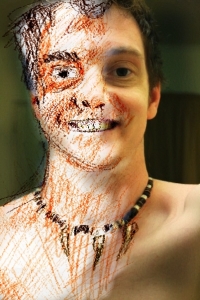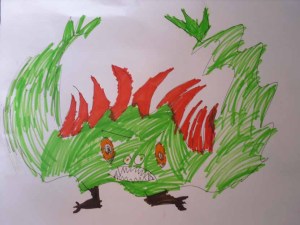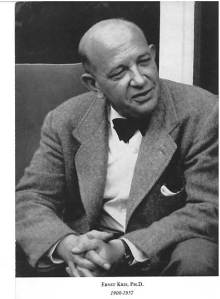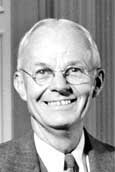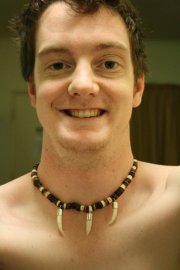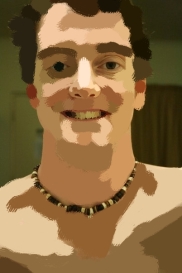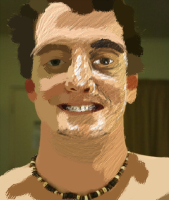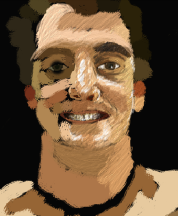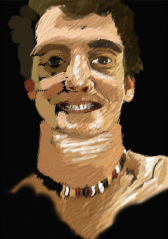Filed under: CCA1103, The six posts for Mark | Tags: creative, data, genome, human, Ideas, industry, inspiration, knowledge, oil, passion, project, risk, seismic, software, waveform
As much as I would love to study full-time the realities of life make this impossible. So when I’m not at university chasing my dream to be a visual artist I’m in an office processing masses of data and making maps for the oil industry. Which brings me to this awesome software we have helped test and develop for its creator (Dirstein and Fallon, 2011). I think it makes for a great case study for bringing in elements from different disciplines and industries to really revolutionise the way this industry looks and processes its data. It also makes for a great insight into coming up with amazingly creative ideas from existing technologies.
In the oil industry seismic data is collected and often displayed in 3D for the evaluation of coal and hydrocarbon exploration. To do this a geophysicist has to pick individual horizons which more often than not takes months to complete and only covers the zone of interest. This is where this software is great it enables the automated picking of all horizons in the dataset in hours or days at most. What is truly amazing and creative is how this software does this. It’s based on the Human Genome Project.
So what goes the Human Genome Project have to do with finding oil?
This is the really creative part. The developer saw that the waveforms from seismic data weren’t all that different from the human Chromosomes. Or at least they could be analysed as data in a very similar way. By matching similar waveforms the software is able to create horizons from the data. So without getting bogged down in the technique aspects I’ll leave it there, however I’ll attach a link to a .pdf file of a recent magazine article on the software and the extra work we do with it for those interested.
This illustrates a lot of the topics and ideas addressed so far in this unit.
- To be always aware and have a genuine thirst for knowledge.
- To look outside your field or profession for inspiration.
- To entertain all ideas.
- To take a risk or leap of faith and chase those ideas.
- To surround yourself with people who stimulate you and your ideas.
- To make it your passion.
It is really inspiring to be involved with these sorts of projects as they are dynamic and ever-changing. It’s like being invited on a journey of discovery. It’s also unhindered by established dogma and rules because whats around the corner is unknown. I find it all very exciting for it’s as much about the journey as the destination. It is for this reason I consider myself creative.
References
Dirstein, J.K. and Fallon, G.N. (2011, April). Automated interpretation of 3D seismic. Preview, issue 151, p30-37. Link to .pdf
Filed under: CCA1103, Creative Project | Tags: art, childlike, creative, drawing, left, photo, portrait, project, right, side, tablet
Wasn’t a big fan of my last attempt so had another crack tonight. I really like this version and think it works well as a whole. I opted to keep the left side photo quality to really draw the focus to the creative side. I think I managed to strike a good balance between recognisable and childlike.
What do you think?
Filed under: CCA1103, Creative Project | Tags: balance, child, contour, creative, difficult, lines, orange, portrait, project
Filed under: CCA1103, Creative Project | Tags: art, childlike, children, colour, drawing, drawings, exploration, google, image, kids, line, mark, project, research
As I start to focus this project now would be a great time to start exploring its specific elements. Since I am drawing one side of the face in a childlike fashion it is only logical to start looking at drawings done by children. Here are a few I found and like using a google image search.
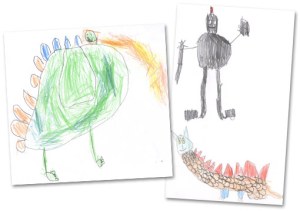
This time its the green but also the change in colour of the spikes on the dragons back. It's a strong decision.
References
6a00d8341cc08553ef00e5540958078834-800wi (n.d) In Google Images [Digital image]. Retrieved May 9, 2011, from; http://belladia.typepad.com/photos/uncategorized/2008/08/17/littlebirdiesmonsterdrawing.jpg
a (n.d) In Google Images [Digital image]. Retrieved May 9, 2011, from; http://4.bp.blogspot.com/_GjitsPnjV4w/SeSGs0HaBVI/AAAAAAAAAQo/msDTle9CFE4/s1600-h/a.jpg
d (n.d) In Google Images [Digital image]. Retrieved May 9, 2011, from; http://1.bp.blogspot.com/_GjitsPnjV4w/SeSGtaUpUqI/AAAAAAAAARA/EBLNakX2paU/s1600-h/d.jpg
kidpic1 (n.d) In Google Images [Digital image]. Retrieved May 9, 2011, from; http://www.baggtheatre.co.uk/images/productions/milligan/kidpic1.jpg
kidpic2 (n.d) In Google Images [Digital image]. Retrieved May 9, 2011, from; http://www.baggtheatre.co.uk/images/productions/milligan/kidpic2.jpg
SDC11141 (n.d) In Google Images [Digital image]. Retrieved May 9, 2011, from; http://3.bp.blogspot.com/_GjitsPnjV4w/Sdn-bJ3H5DI/AAAAAAAAAPc/-LrBigy-8iM/s1600-h/SDC11141.jpg
Filed under: CCA1103, Creative Project | Tags: adult, cca1103, concept, creative, creativity, digital, drawing, Freud, left, painting, portrait, primary, process child, project, right, secondary, tablet
Filed under: CCA1103, The six posts for Mark, Tutorial | Tags: activities, adult, agression, child, childlike, conscious, creative, definition, difficult, environment, ernst, flow, Freud, friend, harold, images, individual, influence, kris, kubie, lawrence, masses, personal, photos, picture, preconscious, preparation, process, project, reality, reinforced, revision, rigid, rugg, sex, sigmund, theories, trueth, unconscious, uncreative
In preparation for my creative project and with the intention to make strong ties back to the unit I’ll be revising the readings and tutorial activities. I’ll be doing this with particular interest to how I can relate it back to my creative project. First up will be the Theories of Creativity (Davis, 2004).
Creativity is a hard thing to define as I believe it is a very personal experience that can be strongly influenced by the environment the individual finds themselves in. I think this is reinforced by the various theories in regards to creativity itself. All have a little truth to them for the masses but are likely true to the individual. What fits for them doesn’t always fit for others and just as what fits others doesn’t always fit them. For me it’s more about the bigger picture and picking what best suits you and your creativity. A good friend of mine didn’t want to share her ideas for a project in another unit which I found a little difficult to understand at first. Personally I like to share ideas freely and build on the ideas created by the ‘flow’ of the group. These new ideas excite me and push me to further build upon them privately. For reasons unknown to me this very thing I find helpful to my process could stifle hers. She could see it as a dilution of her ideas. However I digress, my point being that while these theories might not fit you perfectly they’ll help you understand your creativity and what works for you.
First up is probably the most famous and controversial, Sigmund Freud‘s psychoanalytic account. Putting aside Freud’s obsession with sex he did have an interesting point about the primary and secondary processes. One that I could possibly relate back to my creative project. According to Freud our thinking process could be broken into two different categories; the primary and secondary processes. The primary being a childlike regression where the mind is free, relaxed and able to fantasize without restriction – an ideal environment to be creative. While the secondary is the adultlike way of thinking where reality and logic restrict our thinking. So I could in corporate a childlike element into my portrait for the right side. Maybe even dig up a childhood portrait of myself. I could also use crayons as the medium.
Ernst Kris worked closely with Freud before coming up with his own slightly modified version. Like Freud he was also focused on sex but felt aggression was an important factor too. What an interesting pair these two would have made! Kris believe creativity was a preconscious activity and therefore ideas just happen as an “Eureka” moment and had very little to do with conscious thought. I couldn’t disagree more so on to the next!
Lawrence Kubie breaks down creativity into three states; the conscious, preconscious and unconscious. He claims the conscious and unconscious are rigid and uncreative. The conscious anchored in reality while the unconscious is vague and meanings hidden or repressed. However through various techniques you can reach the threshold between the two and understand the unconscious while remaining in a conscious state. It is the ability of the individual to access this state (preconscious) that determines their creativity. Another theory I don’t agree with personally. I believe we have a more active role in our ability to create than Kubie gives us credit for.
Harold Rugg ‘s theory although basically the same as Kubie’s does have one important difference that make’s it more feasible in my opinion. That the preconscious is a more easily attainable state than what Kubie would have us believe. Much like Freud and his theories on primary and secondary thinking the preconscious is the childlike state and the conscious is the adultlike state. The preconscious state brings the ideas to life while the conscious state brings them to reality.
To be continued…
References
Davis, G. A. (2004). Definitions and Theories. Creativity is forever (pp. 58-73). (5th Ed.). USA: Kendell/Hunt. Download .pdf handout
Ernst%20Kris (n.d) In Google Images [Digital image]. Retrieved May 10, 2011, from; http://www.apsa.org/centennialstatic/Notable%20Psychoanalysts/Ernst%20Kris.jpg
HaroldRugg (n.d) In Google Images [Digital image]. Retrieved May 10, 2011, from; http://www.sandiegoyesterday.com/wp-content/uploads/2011/03/HaroldRugg.jpg
Lawrence%20Kubie (n.d) In Google Images [Digital image]. Retrieved May 10, 2011, from; http://www.apsa.org/centennialstatic/Notable%20Psychoanalysts/Lawrence%20Kubie.jpg
sigmund-freud-med (n.d) In Google Images [Digital image]. Retrieved May 10, 2011, from; http://www.nndb.com/people/736/000029649/sigmund-freud-med.jpg
Filed under: CCA1103, Creative Project | Tags: animation, art, arts, cca1103, creative, drawing, feedback, flow, image, painting, photo, photography, portraits, process, project, push, skills, tablet, technical, test, uni, university, visual
Filed under: CCA1103, Creative Project | Tags: animation, art, camera, cca1103, concept, creative, enjoy, harman, idea, illustrate, investigation, john, portrait, problem, project, Representation, stop, surface, tripod, visual, whiteboard
I have spent a fair amount of time on the creative portrait concept so figured it was time to investigate the first idea I had. Harman, J (2011) pointed out the importance to “entertain all ideas” not based on its merit but on where it may lead. If you recall I was interested in creating a visual representation of the creative process. I was inspired from a video I found on the net where an animation was created from graffiti (or street art depending on who you are). Here is a link to the original post if you are still a little hazy: Creative Project #001.
First thing was to find a surface that I could use legally. More importantly a surface I could draw or paint images on top of each other in rapid succession. After some consideration a whiteboard came to mind. The main problem I found using this surface however was how reflective it was. Will have to look into ways to minimize this if this is the way I decide to go. I setup a tripod with a camera and began a trial run. I had a very basic idea of what I wanted to do but it was still very much on the fly. Will definitely have to storyboard in the future. This short animation is called ‘how ideas are made’. The plan is to illustrate the whole creative process. Enjoy and let me know what you think!
References
Harman, J (2011). Personal Creative Process: John Harman.
http://sandbox.ea.ecu.edu.au/staffuse/mtmcmaho/CCA1103/CCA1103L3/index.html
Filed under: CCA1103, Creative Project | Tags: alter, art, arts, better, created, creative, dad, design, display, download, ego, gimp, graphic, happy, help, illegal, image, jim, next, photo, photography, photoshop, portrait, present, program, project, question, sinister, software, success, visual
Filed under: CCA1103, Creative Project | Tags: auto, break, camera, cohesion, conditions, consistency, course, crash, creative, ecu, editor, labs, photo, photography, portrait, powerpoint, project, software
I did a test shot last weekend with my dad. What I learnt was I really need some photo editing software on my home computer. Using PowerPoint as your editor only gets you so far! It is the reason for the stupid white line running down the middle of the picture. I think I’ll be taking up residency in the ECU computer labs over the break.
I did decide however I wanted to take the photos under the same conditions to keep a consistency and cohesion for the project. Looks like I’ll be chasing up Franco for a crash course in photography! My camera will be for the very first time venturing from the full auto setting.
